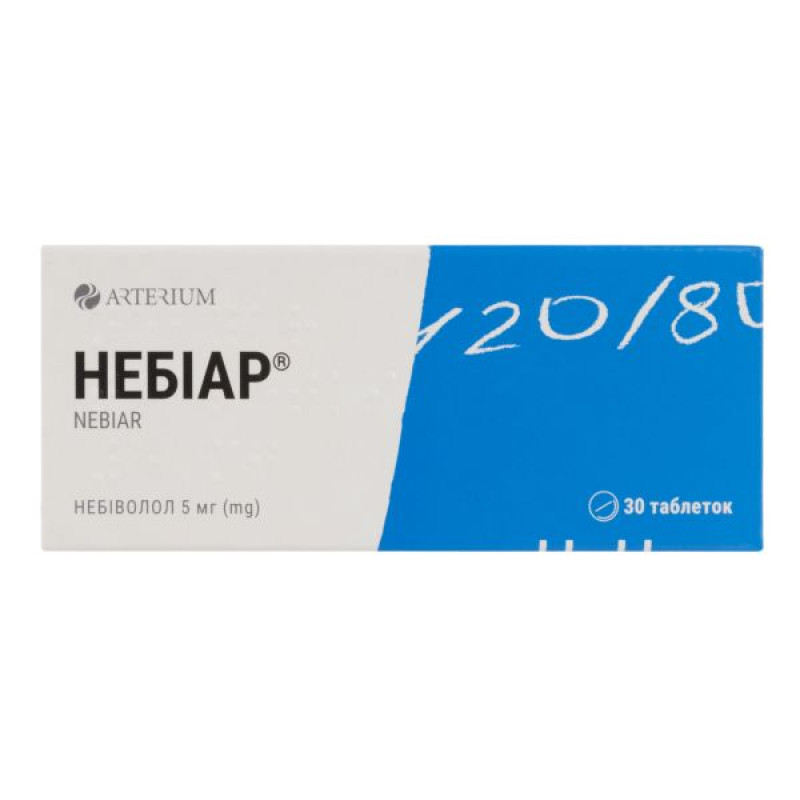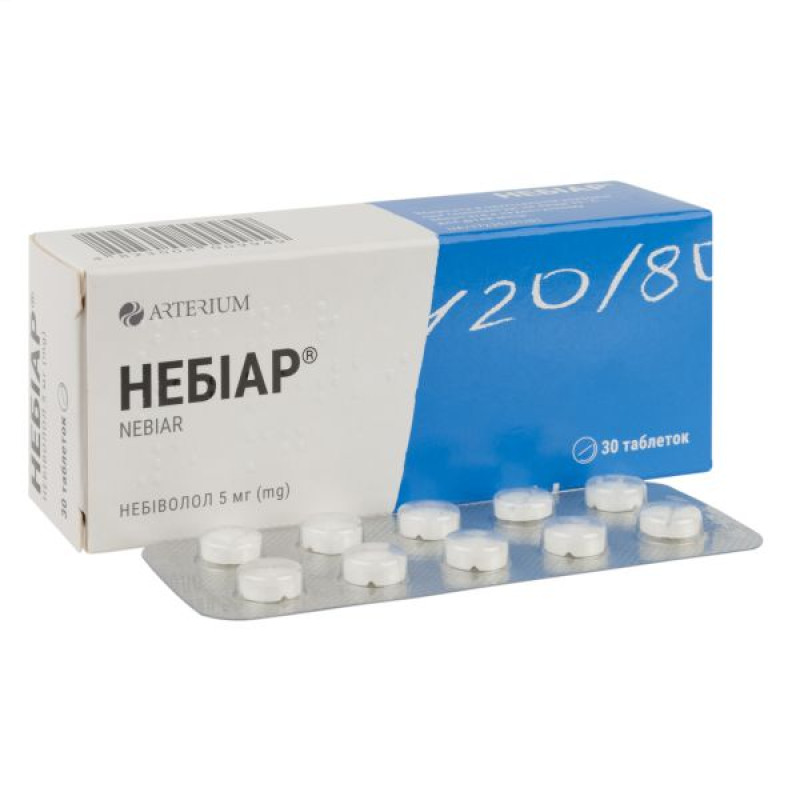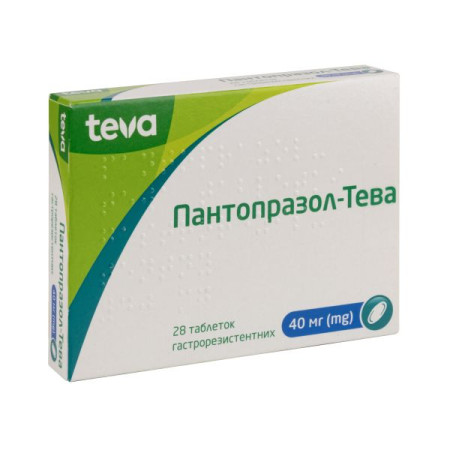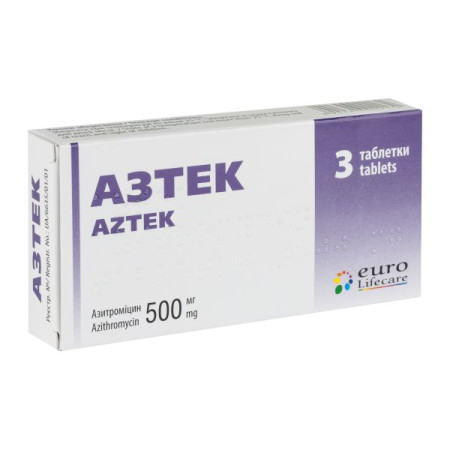Nebiar tablets 5 mg blister No. 30
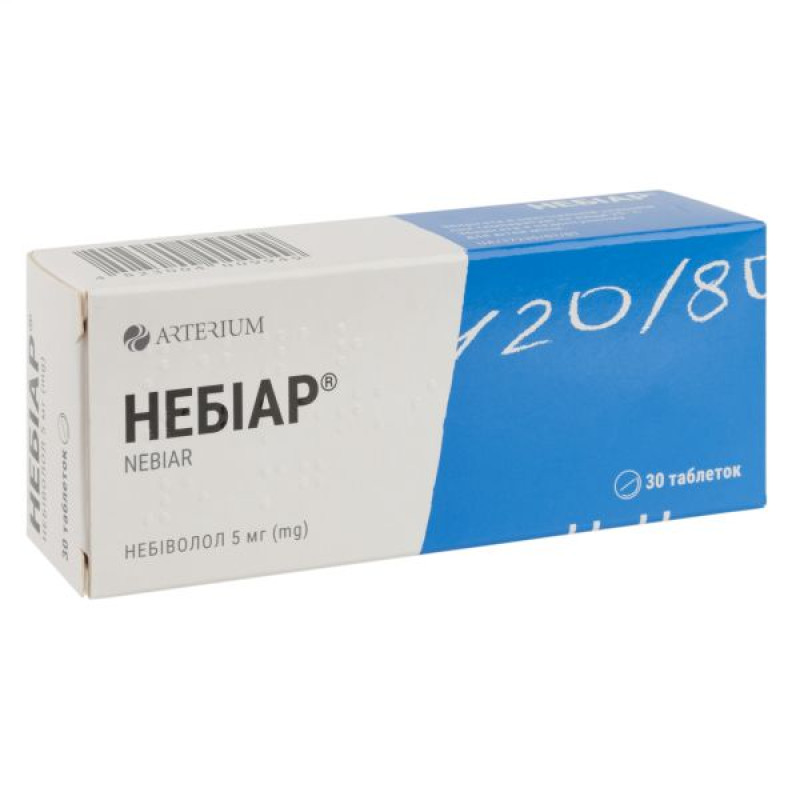
Instructions Nebiar tablets 5 mg blister No. 30
Composition
active ingredient: nebivolol;
1 tablet contains: nebivolol (as nebivolol hydrochloride) - 5 mg;
Excipients: colloidal anhydrous silica (silica gel colloidal anhydrous); magnesium stearate; croscarmellose sodium; polyethylene glycol (PEG 6000); lactose monohydrate.
Dosage form
Pills.
Main physicochemical properties: white, round tablets with a biconvex surface, 9 mm in diameter, with a cross-shaped score on one side of the tablet and the “N5” logo on the other.
Pharmacotherapeutic group
Selective β-adrenergic blockers.
ATX code C07A B12.
Pharmacological properties
Pharmacodynamics.
Nebivolol is a racemate consisting of two enantiomers: SRRR-nebivolol (D-nebivolol) and RSSS-nebivolol (L-nebivolol). It combines two pharmacological properties:
it is a competitive and selective antagonist of β-receptors: this effect is explained by the SRRR enantiomer (d-enantiomer);
It has mild vasodilator properties due to its interaction with L-arginine/nitric oxide.
Single and repeated administration of nebivolol reduces heart rate and blood pressure at rest and during exercise in both normotensive and hypertensive subjects. The antihypertensive effect is maintained during long-term treatment.
At therapeutic doses, α-adrenergic antagonism is not observed.
During short-term and long-term treatment with nebivolol in patients with arterial hypertension, systemic vascular resistance decreases. Despite the decrease in heart rate, the decrease in cardiac output at rest and during exercise is limited due to the increase in stroke volume. The clinical significance of this hemodynamic difference compared with other β-adrenergic blockers is not yet fully understood.
In patients with hypertension, nebivolol increases the vascular response to acetylcholine (ACh) mediated by nitric oxide; in patients with endothelial dysfunction, this response is reduced.
In a placebo-controlled mortality-morbidity study involving 2128 patients aged ≥ 70 years (mean age 75.2 years) with stable chronic heart failure with or without reduced left ventricular ejection fraction (LVEF) (mean LVEF 36 ± 12.3% with the following distribution: LVEF less than 35% in 56% of patients, LVEF 35–45% in 25% of patients, LVEF greater than 45% in 19% of patients), lasting an average of 20 months, nebivolol as the main drug in the composition of standard therapy significantly prolonged the time to death or hospitalization due to cardiovascular pathology (primary efficacy endpoint) with a relative risk reduction of 14% (absolute reduction - 4.2%). This risk reduction developed after 6 months of treatment and was maintained throughout the treatment period (median duration 18 months). The effect of nebivolol was independent of age, gender or left ventricular ejection fraction of the study participants. The benefit in preventing all-cause mortality compared with placebo did not reach statistical significance (absolute reduction 2.3%).
Patients treated with nebivolol had a reduced incidence of fatal events (4.1% versus 6.6%, a relative reduction of 38%).
In vitro and in vivo animal experiments have shown that nebivolol does not have its own sympathomimetic activity.
In vitro and in vivo animal experiments have shown that nebivolol in pharmacological doses does not have a stabilizing effect on membranes.
In healthy volunteers, nebivolol does not have a significant effect on the ability to tolerate maximum physical exertion or on endurance.
Available preclinical and clinical data have not shown that nebivolol negatively affects erectile function in patients with hypertension.
Pharmacokinetics.
After oral administration, both enantiomers of nebivolol are rapidly absorbed. The absorption of nebivolol is not affected by food, so it can be taken with or without food.
In extensive metabolizers, the half-life of the enantiomers of nebivolol is on average 10 hours. In poor metabolizers, this value is 3–5 times higher. In extensive metabolizers, the concentration of the RSSS enantiomer is slightly higher than that of the SRRR enantiomer. In extensive metabolizers, this difference is greater.
In individuals with rapid metabolizers, the half-life values of the hydroxymetabolites of both enantiomers average 24 hours, and in individuals with slow metabolizers, these values are approximately 2 times greater.
Steady-state plasma levels are reached within 24 hours in most patients with rapid metabolism, and within several days for hydroxymetabolites.
The plasma concentration, which ranges from 1 to 30 mg of nebivolol, is proportional to the dose. The pharmacokinetics of nebivolol are not affected by age.
In plasma, both enantiomers are predominantly bound to albumin. Plasma protein binding is 98.1% for SRRR-nebivolol and 97.9% for RSSS-nebivolol.
One week after administration, 38% of the dose is excreted in the urine and 48% in the feces. Renal excretion of unchanged nebivolol is less than 0.5% of the dose.
Preclinical safety data.
Preclinical data reveal no special hazard for humans based on conventional studies of genotoxicity, reproductive toxicity, developmental toxicity and carcinogenicity. Adverse effects on reproductive function were observed only at high doses, several times the maximum recommended human dose (see section "Use during pregnancy and lactation").
Indication
Arterial hypertension
Treatment of essential arterial hypertension.
Chronic heart failure (CHF)
Treatment of mild to moderate chronic heart failure as an adjunct to standard treatment methods in patients aged 70 years and older.
Chronic ischemic heart disease (CIHD)
Treatment of symptomatic chronic ischemic heart disease.
Contraindication
Hypersensitivity to the active substance or to other components of the medicinal product;
liver failure or liver function impairment;
acute heart failure, cardiogenic shock or episodes of decompensated heart failure requiring intravenous administration of active substances with a positive inotropic effect.
In addition, like other β-blockers, Nebiar® is contraindicated in the following diseases:
sick sinus syndrome, including sinoatrial block,
AV block II-III degree (without artificial pacemaker);
bronchospasm and bronchial asthma in history;
untreated pheochromocytoma;
metabolic acidosis;
bradycardia (before the start of treatment, the heart rate is less than 60 beats/min);
arterial hypotension (systolic blood pressure less than 90 mm Hg);
severe peripheral circulatory disorders.
Interaction with other medicinal products and other types of interactions
Pharmacodynamic interactions
Below is general information regarding interactions with β-adrenergic antagonists.
Concomitant use is not recommended:
a) with class I antiarrhythmic drugs (quinidine, hydroquinidine, cibenzoline, flecainide, disopyramide, lidocaine, mexiletine, propafenone) - the effect on AV conduction may be enhanced and the negative inotropic effect may increase;
b) with calcium antagonists such as verapamil/diltiazem – negative effect on AV conduction and myocardial contractility. Intravenous administration of verapamil to patients taking β-blockers can lead to significant arterial hypotension and AV block;
c) with centrally acting antihypertensive drugs (clonidine, guanfacine, moxonidine, methyldopa, rilmenidine) - may lead to worsening of heart failure due to a decrease in heart rate, stroke volume and vasodilation. With sudden withdrawal, in particular before the end of the use of β-blockers, the likelihood of an increase in blood pressure (withdrawal syndrome) may increase.
Caution should be exercised when using simultaneously:
a) with class III antiarrhythmic drugs (amiodarone) - the effect on AV conduction may be increased;
b) with halogenated volatile anesthetics - may suppress reflex tachycardia and increase the risk of arterial hypotension. If the patient uses Nebiar®, the anesthesiologist should be informed about this;
c) with insulin and oral antidiabetic agents – although Nebiar® does not affect blood glucose levels, it may still mask symptoms of hypoglycemia such as tachycardia and palpitations;
d) with baclofen (antispastic agent), amifostine (additional antitumor agent) - their simultaneous use with antihypertensive agents can lead to a significant decrease in blood pressure, so the dose of antihypertensive agents should be adjusted accordingly.
When used simultaneously, the following should be considered:
b) dihydropyridine-type calcium antagonists (amlodipine, felodipine, lacidipine, nifedipine, nicardipine, nimodipine, nitrendipine) - the risk of arterial hypotension increases, and in patients with heart failure, ventricular pumping function may deteriorate;
c) antipsychotics, antidepressants (tricyclic antidepressants, barbiturates, phenothiazine derivatives) – antihypertensive effect may be increased (principle of additive effects);
d) nonsteroidal anti-inflammatory drugs - do not affect the antihypertensive effect of Nebiar;
e) sympathomimetics – may counteract the antihypertensive effect of β-blockers. Active substances with β-adrenergic action may lead to unhindered α-adrenergic activity of sympathomimetics with the presence of both α- and β-adrenergic effects (risk of developing arterial hypertension, severe bradycardia and heart block).
Interactions due to the pharmacokinetics of the drug:
Since the CYP2D6 isoenzyme is involved in the metabolism of nebivolol, the simultaneous use of drugs that inhibit this enzyme (paroxetine, fluoxetine, thioridazine, quinidine) increases the level of nebivolol in the blood plasma and thus increases the risk of excessive bradycardia and other adverse reactions;
Cimetidine increases the plasma levels of nebivolol, but without changing the clinical efficacy. Ranitidine does not affect the pharmacokinetics of nebivolol;
provided that Nebiar® is taken with meals and the antacid is taken between meals, these drugs can be prescribed together;
with simultaneous use of nebivolol and nicardipine, the concentrations of both substances in the blood plasma slightly increased without changing the clinical efficacy;
simultaneous use of alcohol, furosemide or hydrochlorothiazide does not affect the pharmacokinetics of nebivolol;
Nebivolol does not affect the pharmacodynamics and pharmacokinetics of warfarin.
Application features
The following warnings and precautions are common to beta-adrenergic blockers.
Anesthesia.
Maintenance of β-blockade reduces the risk of cardiac arrhythmias during induction of anesthesia and intubation. In preparation for surgery, β-blockers should be discontinued for at least 24 hours. Caution is required when using certain anesthetics that cause myocardial depression, such as cyclopropane, ether, or trichloroethylene. Vagal reactions in the patient can be prevented by intravenous atropine.
Cardiovascular system.
As a rule, patients with untreated chronic heart failure should not be prescribed β-blockers until their condition is stable. β-blocker therapy should be discontinued in patients with ischemic heart disease gradually, i.e. over 1–2 weeks. If necessary, it is recommended to start treatment with a replacement drug at the same time to prevent exacerbation of the disease. β-blockers can cause bradycardia. If the resting heart rate decreases to 50–55 beats per minute and/or the patient develops symptoms indicating bradycardia, the dose is recommended to be reduced. β-blockers should be used with caution in the treatment of: a) patients with peripheral circulatory disorders (Raynaud's disease or syndrome, intermittent claudication), as exacerbation of these diseases may develop; b) patients with first-degree atrioventricular block due to the negative effect of β-adrenergic blockers on conduction; c) patients with Prinzmetal's angina due to unobstructed vasoconstriction of the coronary arteries mediated through α-adrenergic receptors: β-adrenergic blockers may increase the frequency and duration of angina attacks.
The combination of nebivolol with calcium antagonists such as verapamil and diltiazem, with group I antiarrhythmics, as well as with centrally acting antihypertensives is not recommended at all.
Metabolism and endocrine system.
Nebivolol® does not affect blood glucose levels in patients with diabetes mellitus. However, caution should be exercised when using it to treat patients in this category, as nebivolol may mask some signs of hypoglycemia, such as tachycardia and palpitations. β-adrenergic blockers may mask the symptoms of tachycardia in hyperthyroidism. These symptoms may worsen if therapy is abruptly discontinued.
Respiratory system.
In patients with chronic obstructive airways disease, β-adrenergic blockers should be used with caution as airway constriction may be exacerbated.
Other.
Patients with a history of psoriasis should be prescribed β-blockers only after careful consideration.
Beta-adrenergic blockers may increase sensitivity to allergens and the severity of anaphylactic reactions.
At the beginning of treatment with nebivolol for chronic heart failure, regular monitoring of the patient is necessary. Treatment should not be abruptly discontinued unless absolutely necessary.
The drug contains lactose monohydrate, so it should not be taken by patients with hereditary galactose intolerance, lactase deficiency or glucose-galactose malabsorption syndrome.
Use during pregnancy or breastfeeding
The pharmacological effects of nebivolol may adversely affect the course of pregnancy, the fetus and the infant.
In general, β-blockers reduce placental blood flow, which has been associated with growth retardation, intrauterine death, miscarriage, and premature birth. Adverse effects (e.g., hypoglycemia and bradycardia) may occur in the fetus and newborn. If treatment with β-blockers is necessary, β1-selective agents are preferable.
β-blockers.
Nebivolol should not be used during pregnancy unless clearly necessary.
If nebivolol treatment is necessary, uteroplacental circulation and fetal growth should be monitored. If adverse effects are confirmed, alternative treatment should be considered. The fetus should be closely monitored and symptoms such as hypoglycemia and bradycardia should be expected during the first 3 days.
Breastfeeding period
Animal studies have shown that nebivolol passes into breast milk. It is not known whether nebivolol passes into human breast milk. Animal studies have shown that nebivolol passes into breast milk. Most beta-blockers, especially lipophilic compounds such as nebivolol, pass into breast milk, although to varying degrees. Therefore, breast-feeding is not recommended during treatment with nebivolol.
Fertility
Nebivolol did not affect fertility in rats, except at doses several times the maximum recommended human dose, when adverse effects were observed on the reproductive organs of male and female rats and mice. The effect of nebivolol on human fertility is unknown.
Ability to influence reaction speed when driving vehicles or other mechanisms
Studies on the effect on the reaction rate when driving vehicles or other mechanisms have not been conducted. Pharmacodynamic studies have shown that Nebiar® 5 mg does not affect psychomotor function. However, the possibility of dizziness and fatigue should be taken into account when driving vehicles or other mechanisms.
Method of administration and doses
Dosage regimen
Arterial hypertension.
Adults. The dose is 1 tablet of Nebiar® (5 mg nebivolol) per day, preferably at the same time of day. The hypotensive effect becomes apparent after 1–2 weeks of treatment, but sometimes the optimal effect is observed only after 4 weeks.
Combination with other antihypertensive agents.
Nebiar® can be used both as monotherapy and in combination with other antihypertensive drugs. To date, an additional antihypertensive effect has only been observed when it is combined with 12.5–25 mg of hydrochlorothiazide.
Patients with renal failure.
For patients with renal insufficiency, the recommended initial dose is 2.5 mg per day. If necessary, the daily dose can be increased to 5 mg.
Patients with liver failure.
Data on the use of the medicinal product in patients with hepatic insufficiency or impaired liver function are limited. Therefore, the use of the medicinal product in such patients is contraindicated.
Elderly patients (aged 65 and over).
For this group of patients, the recommended starting dose is 2.5 mg per day. If necessary, it can be increased to 5 mg. However, due to insufficient experience with the drug in patients over 75 years of age, its use requires caution and close monitoring of such patients.
Chronic heart failure.
Treatment of chronic heart failure should be initiated by slow titration to the individual optimal maintenance dose. Such patients should be treated if they have chronic heart failure without episodes of acute decompensation within the past 6 weeks. It is recommended that the physician be experienced in the treatment of chronic heart failure. Patients receiving other cardiovascular medications, including diuretics and/or digoxin and/or angiotensin-converting enzyme (ACE) inhibitors and/or angiotensin II receptor antagonists, should have their doses of these medications titrated for 2 weeks prior to initiating therapy with Nebicard.
If symptoms of heart failure worsen or if the drug is not tolerated during the titration phase, it is recommended to first reduce the dose of nebivolol or, if necessary, immediately discontinue the drug (if severe hypotension occurs, symptoms of heart failure worsen with acute pulmonary edema, cardiogenic shock, symptomatic bradycardia or atrioventricular block occur).
As a rule, treatment of stable chronic heart failure with nebivolol is long-term.
Nebivolol treatment should not be stopped abruptly, as this may lead to temporary worsening of heart failure. If discontinuation of the drug is necessary, the dose should be reduced gradually, reducing it by half at intervals of 1 week.
Chronic ischemic heart disease.
Adults: Treatment of chronic coronary heart disease should begin with a gradual increase in dose until the optimal maintenance dose is determined for each patient.
The initial dose should be increased every 1–2 weeks, depending on tolerability, from 1.25 mg nebivolol to 2.5 mg nebivolol once daily, then to 5 mg once daily, and then to 10 mg once daily. The maximum recommended dose is 10 mg nebivolol once daily. Data for special patient groups apply to patients with both CHF and CKD.
Patients with renal failure.
Since the dose is titrated to the maximum tolerated dose on an individual basis, no dose adjustment is required in mild to moderate renal impairment. There is no experience in patients with severe renal impairment (serum creatinine ≥ 250 μmol/l), therefore the use of nebivolol in such patients is not recommended.
Patients with liver failure.
The use of the drug in patients with hepatic insufficiency is contraindicated due to limited experience.
Elderly patients (aged 65 and over).
Since titration to the maximum tolerated dose is individualized, dose adjustment is not necessary.
Method of application.
Oral use.
The tablets can be taken with food.
Children
The efficacy and safety of Nebiar® in children and adolescents (under 18 years of age) have not been studied. Data are not available. Therefore, use in children and adolescents (under 18 years of age) is not recommended.
Overdose
There are no data on cases of nebivolol overdose.
Symptoms.
In case of overdose of β-blockers, the following are observed: bradycardia, hypotension, bronchospasm, acute heart failure.
Treatment.
In case of overdose or hypersensitivity reactions, the patient should be closely monitored and treated in an intensive care unit. Blood glucose monitoring is recommended. The absorption of any drug residues still present in the gastrointestinal tract can be prevented by gastric lavage, administration of activated charcoal and laxatives. Artificial ventilation may also be required. Atropine or methyltropine is recommended to reverse bradycardia or increased vagotonia. Hypotension and shock should be treated with plasma/plasma substitutes and, if necessary, catecholamines.
Beta-blocking effect can be stopped by slow intravenous administration of isoprenaline hydrochloride, starting at a dose of 5 μg/min, or dobutamine, starting at a dose of 2.5 μg/min, until the desired effect is achieved. In resistant cases, isoprenaline can be combined with dopamine. If the above measures do not help, glucagon should be administered at a rate of 50–100 μg/kg, if necessary - the injection can be repeated within an hour and, if necessary, an intravenous infusion of glucagon at a rate of 70 μg/kg/h can be performed. In extreme cases of bradycardia resistant to therapy, an artificial pacemaker can be connected.
Side effects
Adverse reactions in essential hypertension and chronic heart failure are listed separately due to the differences in the pathological processes underlying these diseases.
Essential hypertension.
System organs | Often (≥ 1/100 to < 1/10) | Rarely (≥ 1/1000 to < 1/100) | Very rare (≥ 1/10000) | Frequency unknown |
| On the part of the immune system | Angioedema, hypersensitivity | |||
| From the psyche | Nightmares, depression | |||
| From the nervous system | Headache, dizziness, paresthesia | Syncope | ||
| From the organs of vision | Vision impairment | |||
| From the heart | Bradycardia, heart failure, AV conduction delay/AV block | |||
| From the vascular side | Arterial hypotension, increased intermittent claudication | |||
| Respiratory tract | Dyspnea | Bronchospasm | ||
| From the digestive tract | Constipation, nausea, diarrhea | Dyspepsia, flatulence, vomiting | ||
| From the skin side | Pruritus, erythematous skin rash | Worsening of psoriasis | Urticaria | From the genitals | Impotence |
| General disorders | Increased fatigue, edema |
In addition, the following adverse reactions have been reported with some β-blockers: hallucinations, psychosis, confusion, coldness/cyanosis of the extremities, Raynaud's syndrome, dry eyes, and practolol-type ocular-mucocutaneous toxicity.
Chronic heart failure.
Adverse reactions in patients with heart failure were reported in placebo-controlled clinical trials in which 1067 patients received nebivolol and 1061 patients received placebo. In this study, a total of 449 patients (42.1%) on nebivolol and 334 (31.5%) on placebo reported adverse reactions that were possibly related to the drug. The most common adverse reactions reported by patients receiving nebivolol were bradycardia and dizziness, which occurred in approximately 11% of patients. The corresponding incidences in patients receiving placebo were approximately 2% and 7%, respectively.
Adverse reactions that are at least potentially related to the use of the drug and that were considered characteristic and significant in the treatment of chronic heart failure:
worsening heart failure was observed in 5.8% of patients receiving nebivolol and 5.2% of patients receiving placebo;
Orthostatic hypotension occurred in 2.1% of patients receiving nebivolol and 1% of patients receiving placebo;
Drug intolerance was observed in 1.6% of patients receiving nebivolol and in 0.8% of patients receiving placebo;
First-degree AV block was observed in 1.4% of patients receiving nebivolol and in 0.9% of patients receiving placebo;
Lower limb edema occurred in 1% of patients treated with nebivolol and 0.2% of patients treated with placebo.
Chronic ischemic heart disease.
The adverse reaction data in patients with CHF were obtained by a special analysis of data from the same clinical study as described for CHF. It can be reasonably assumed that the safety and tolerability results of nebivolol obtained in patients with CHF are also applicable to patients with CHF.
Reporting adverse reactions after the registration of a medicinal product is important. This allows monitoring of the benefit/risk ratio of the medicinal product. Medical and pharmaceutical professionals, as well as patients or their legal representatives, should report all cases of suspected adverse reactions and lack of efficacy of the medicinal product via the automated pharmacovigilance information system at the following link: https://aisf.dec.gov.ua.
Expiration date
3 years from the date of manufacture in bulk.
Storage conditions
In the original packaging at a temperature not exceeding 25 °C.
Keep out of reach of children.
Packaging
10 tablets in a blister. 3 blisters of 10 tablets together with instructions for medical use are placed in a pack.
Vacation category
According to the recipe.
Producer
PJSC "Kyivmedpreparat" (production from bulk products of the manufacturer ACTAVIS LTD, Malta, the manufacturer "Balkanpharma-Dupnitsa" AD, Bulgaria).
Location of the manufacturer and address of its place of business
Ukraine, 01032, Kyiv, Saksaganskoho St., 139.
Applicant
LLC "ARTERIUM LTD".
Location of the applicant and/or applicant's representative
Ukraine, 01032, Kyiv, Saksaganskoho St., 139.
There are no reviews for this product.
There are no reviews for this product, be the first to leave your review.
No questions about this product, be the first and ask your question.







